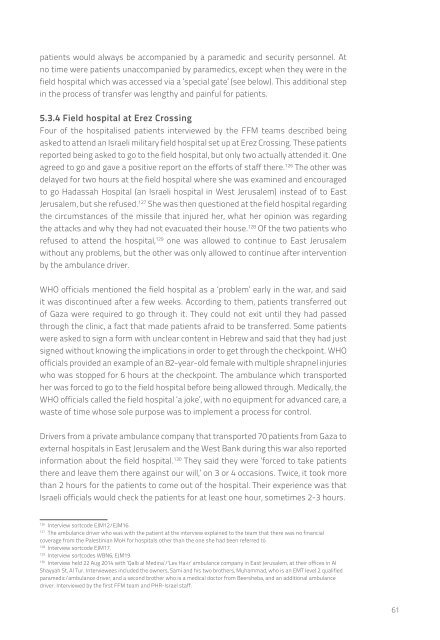HHo0s
HHo0s
HHo0s
Create successful ePaper yourself
Turn your PDF publications into a flip-book with our unique Google optimized e-Paper software.
patients would always be accompanied by a paramedic and security personnel. Atno time were patients unaccompanied by paramedics, except when they were in thefield hospital which was accessed via a ‘special gate’ (see below). This additional stepin the process of transfer was lengthy and painful for patients.5.3.4 Field hospital at Erez CrossingFour of the hospitalised patients interviewed by the FFM teams described beingasked to attend an Israeli military field hospital set up at Erez Crossing. These patientsreported being asked to go to the field hospital, but only two actually attended it. Oneagreed to go and gave a positive report on the efforts of staff there. 126 The other wasdelayed for two hours at the field hospital where she was examined and encouragedto go Hadassah Hospital (an Israeli hospital in West Jerusalem) instead of to EastJerusalem, but she refused. 127 She was then questioned at the field hospital regardingthe circumstances of the missile that injured her, what her opinion was regardingthe attacks and why they had not evacuated their house. 128 Of the two patients whorefused to attend the hospital, 129 one was allowed to continue to East Jerusalemwithout any problems, but the other was only allowed to continue after interventionby the ambulance driver.WHO officials mentioned the field hospital as a ‘problem’ early in the war, and saidit was discontinued after a few weeks. According to them, patients transferred outof Gaza were required to go through it. They could not exit until they had passedthrough the clinic, a fact that made patients afraid to be transferred. Some patientswere asked to sign a form with unclear content in Hebrew and said that they had justsigned without knowing the implications in order to get through the checkpoint. WHOofficials provided an example of an 82-year-old female with multiple shrapnel injurieswho was stopped for 6 hours at the checkpoint. The ambulance which transportedher was forced to go to the field hospital before being allowed through. Medically, theWHO officials called the field hospital ‘a joke’, with no equipment for advanced care, awaste of time whose sole purpose was to implement a process for control.Drivers from a private ambulance company that transported 70 patients from Gaza toexternal hospitals in East Jerusalem and the West Bank during this war also reportedinformation about the field hospital. 130 They said they were ‘forced to take patientsthere and leave them there against our will,’ on 3 or 4 occasions. Twice, it took morethan 2 hours for the patients to come out of the hospital. Their experience was thatIsraeli officials would check the patients for at least one hour, sometimes 2-3 hours.126Interview sortcode EJM12/EJM16.127The ambulance driver who was with the patient at the interview explained to the team that there was no financialcoverage from the Palestinian MoH for hospitals other than the one she had been referred to.128Interview sortcode EJM17.129Interview sortcodes WBN6, EJM19.130Interview held 22 Aug 2014 with ‘Qalb al Medina’/’Lev Ha›ir’ ambulance company in East Jerusalem, at their offices in AlShayyah St, Al Tur. Interviewees included the owners, Sami and his two brothers, Muhammad, who is an EMT level 2 qualifiedparamedic/ambulance driver, and a second brother who is a medical doctor from Beersheba, and an additional ambulancedriver. Interviewed by the first FFM team and PHR-Israel staff.61


